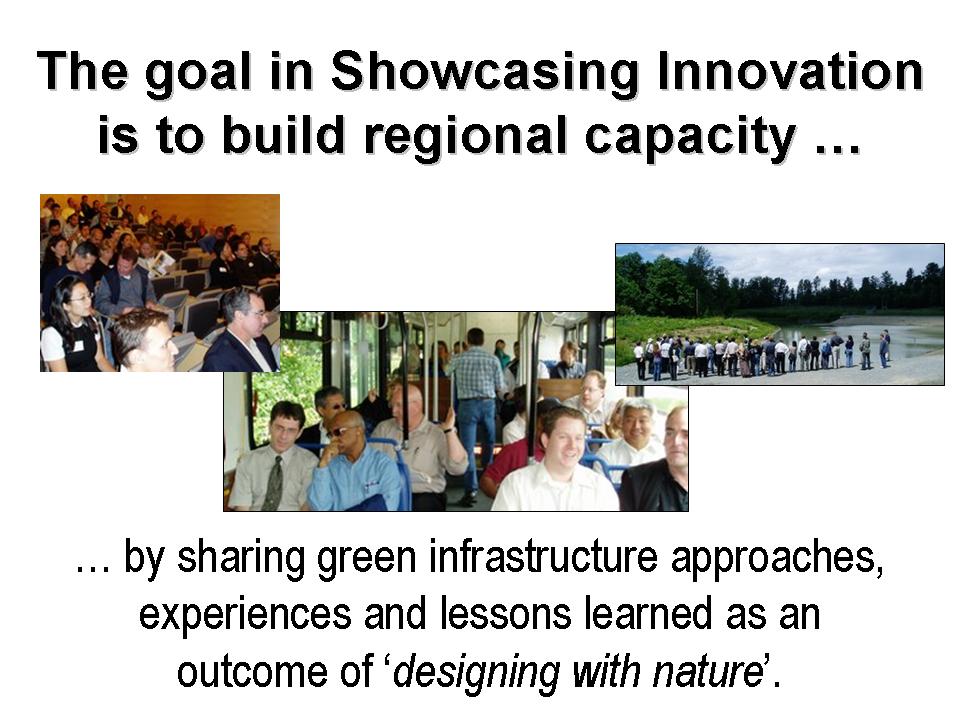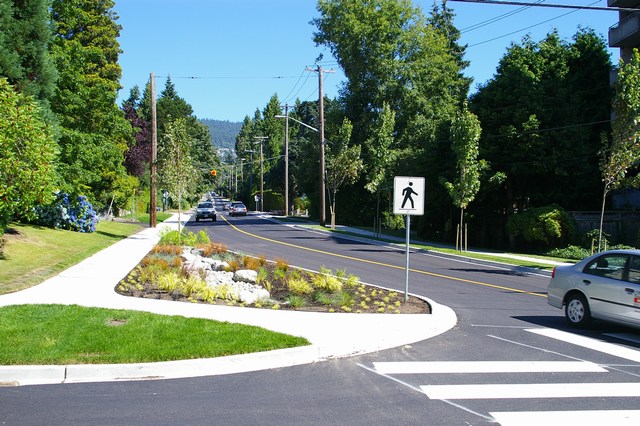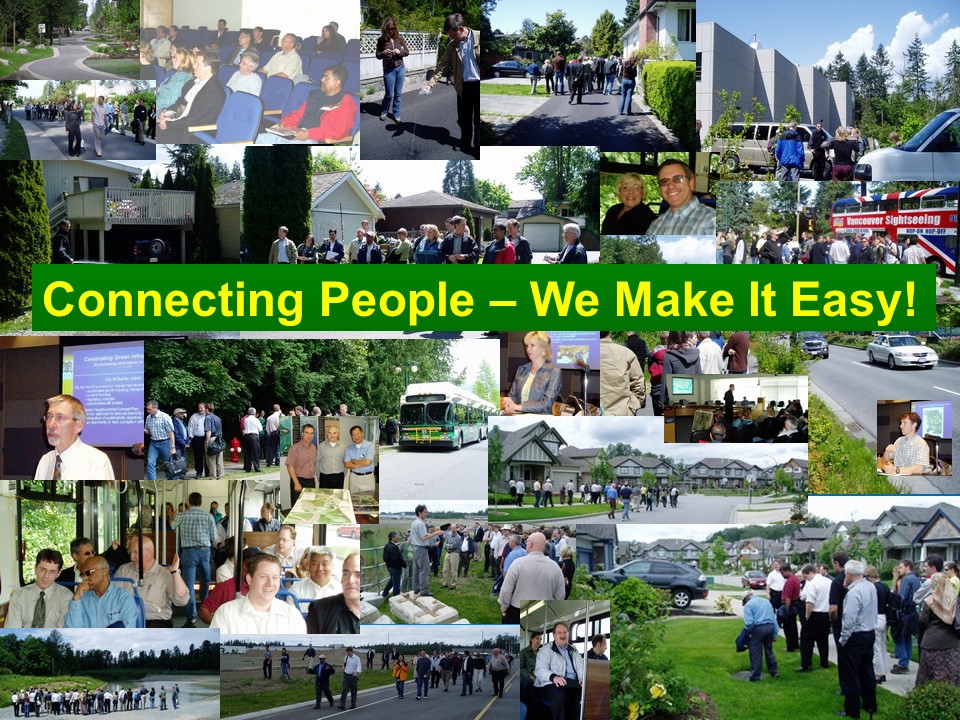West Vancouver Mayor Teams with Green Infrastructure Partnership to Champion ‘Design with Nature’ Approaches
Green infrastructure presentation at GVRD Sustainability Community Breakfast draws large crowd
Building on the momentum generated by an October 2006 presentation to the Sustainable Region Initiative Task Force, the Green Infrastructure Partnership brought its ‘design with nature’ message to an audience of 80-plus at a Sustainability Community Breakfast hosted by the Greater Vancouver Regional District on December 13, 2006. West Vancouver Mayor Pamela Goldsmith-Jones again played a key role in anchoring the presentation team and articulating the importance of partnerships.
 “The challenge for high growth communities is to make informed choices that will produce cumulative benefits over time, and thereby ensure long-term community vitality and liveability”, explained Mayor Goldsmith-Jones, “In recent decades, Greater Vancouver and other high growth regions in British Columbia have been experiencing enhanced social and economic well-being; they have also experienced avoidable cumulative environmental impacts due to pressures on land and water resources.”
“The challenge for high growth communities is to make informed choices that will produce cumulative benefits over time, and thereby ensure long-term community vitality and liveability”, explained Mayor Goldsmith-Jones, “In recent decades, Greater Vancouver and other high growth regions in British Columbia have been experiencing enhanced social and economic well-being; they have also experienced avoidable cumulative environmental impacts due to pressures on land and water resources.”
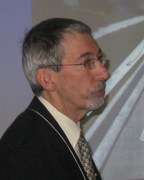 According to Paul Ham, Chair of the Green Infrastructure Partnership (and General Manager, Engineering, City of Surrey): “Because the way we develop land determines how water is used and how water runs off the land, the desire to mitigate environmental impacts has provided a driver for the ‘green infrastructure’ movement. Infrastructure design in British Columbia is changing because we recognize that instead of incurring costs and losses, we can achieve cumulative benefits through changes in the policies, programs, practices and standards that determine how land is developed and water is used.”
According to Paul Ham, Chair of the Green Infrastructure Partnership (and General Manager, Engineering, City of Surrey): “Because the way we develop land determines how water is used and how water runs off the land, the desire to mitigate environmental impacts has provided a driver for the ‘green infrastructure’ movement. Infrastructure design in British Columbia is changing because we recognize that instead of incurring costs and losses, we can achieve cumulative benefits through changes in the policies, programs, practices and standards that determine how land is developed and water is used.”
About the Green Infrastructure Partnership
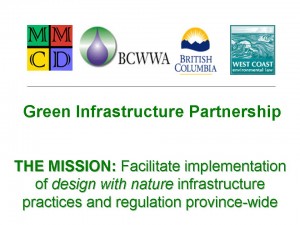 The Green Infrastructure Partnership is a consortium of four organizations: Master Municipal Contract Documents Association (MMCD); West Coast Environmental Law Foundation (WCEL); Ministry of Community Services (MCS); and British Columbia Water & Waste Association (BCWWA). The Water Sustainability Committee of the BCWWA is the managing partner for the Green Infrastructure Partnership.
The Green Infrastructure Partnership is a consortium of four organizations: Master Municipal Contract Documents Association (MMCD); West Coast Environmental Law Foundation (WCEL); Ministry of Community Services (MCS); and British Columbia Water & Waste Association (BCWWA). The Water Sustainability Committee of the BCWWA is the managing partner for the Green Infrastructure Partnership.
Through Convening for Action pilot programs in three regions – Greater Vancouver, Vancouver Island, and the South Okanagan – the mission of the Green Infrastructure Partnership is to provide leadership and encourage others to implement ‘design with nature’ infrastructure practices and regulation province-wide.
Moving from Talk to Action
“The District of West Vancouver has embraced the design with nature language in our 3-year Corporate Business Plan”, reported Mayor Goldsmith-Jones, “A Council goal under the category of Governance Promoting Sustainability is ‘design with nature’ because we believe this way-of-thinking holds the key to ensuring that housing development respects the natural environment and protects neighbourhood character. To understand what this means on the ground, we have undertaken a pilot process with the Clovelly-Caulfeild neighbourhood.”
 In addition to Mayor Goldsmith-Jones and Paul Ham (representing MMCD), the five-person presentation team included Raymond Fung (Chair of the Water Sustainability Committee of the BCWWA), Kim Stephens (Program Coordinator for the Water Sustainability Action Plan for British Columbia), and Susan Rutherford (WCEL Staff Counsel). To view their integrated PowerPoint presentation, please click on this link to Changing the Way We Develop Land: Design with Nature The program was structured as six short segments:
In addition to Mayor Goldsmith-Jones and Paul Ham (representing MMCD), the five-person presentation team included Raymond Fung (Chair of the Water Sustainability Committee of the BCWWA), Kim Stephens (Program Coordinator for the Water Sustainability Action Plan for British Columbia), and Susan Rutherford (WCEL Staff Counsel). To view their integrated PowerPoint presentation, please click on this link to Changing the Way We Develop Land: Design with Nature The program was structured as six short segments:
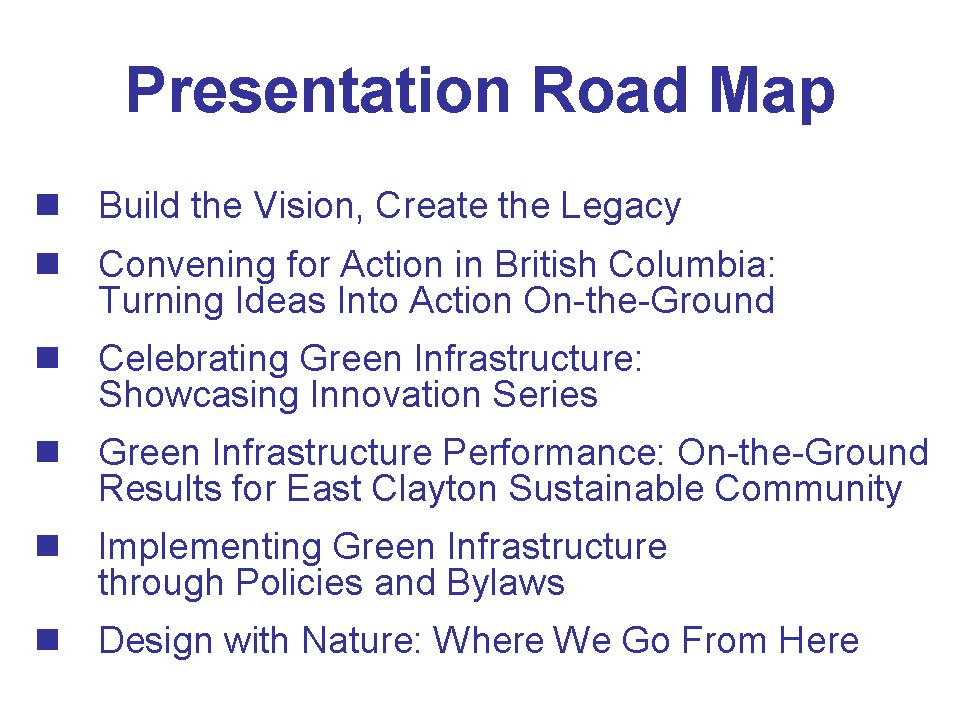 Build the Vision, Create the Legacy
Build the Vision, Create the Legacy
British Columbia has established a precedent-setting approach in blending policy, science plus the application of science, education and outreach in a seamless package: the Water Sustainability Action Plan.
Convening for Action in British Columbia – Turning Ideas Into Action On-the-Ground
 Convening for Action is a ‘made in BC framework for building consensus and capacity by creating a picture of what the future can look like, and then showing how to create that future through implementation of design with nature infrastructure regulations and practices.
Convening for Action is a ‘made in BC framework for building consensus and capacity by creating a picture of what the future can look like, and then showing how to create that future through implementation of design with nature infrastructure regulations and practices.
“Convening for Action is grounded in the world of local government, recognizes that local government is the level of government that controls land use, and aligns federal/provincial infrastructure programs with local needs”, observes Raymond Fung.
Celebrating Green Infrastructure – Showcasing Innovation Series
Until the last couple of years, British Columbians would go to the Seattle region to see what they have built. Now, people are coming from as far away as New Zealand to see what we are doing – for example, delegations from New Zealand have visited both North Van District and Chilliwack.
According to Kim Stephens: “Few regions are attempting to implement green infrastructure on the scale that we are doing it. In the words of Patrick Condon, we are in the process of moving green infrastructure from market-niche to market-share.”
Green Infrastructure Performance – On the Ground Results for East Clayton Sustainable Community
“When Surrey developed the East Clayton Neighbourhood Plan, three initiatives had an early influence on the City’s move to a design with nature approach to drainage: UniverCity on Burnaby Mountain; Stormwater Planning: A Guidebook; for British Columbia 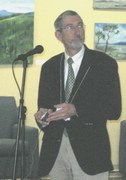 and the Chilliwack experience as a feedback loop during Guidebook development’, reports Paul Ham.
and the Chilliwack experience as a feedback loop during Guidebook development’, reports Paul Ham.
“The early results from East Clayton combined with the Chilliwack experience gave Surrey the confidence to implement design with nature objectives in the City’s land use plans”.
East Clayton set the pace regionally and made it possible for other Greater Vancouver municipalities to follow in Surrey’s wake by implementing green infrastructure at a community scale – for example, Silver Valley in Maple Ridge.
The Federation of Canadian Municipalities recognized what the City of Surrey has accomplished when it honoured the City with a 2006 Sustainable Community Award for East Clayton.
Implementing Green Infrastructure through Policies and Bylaws
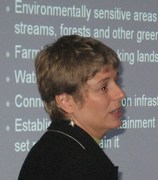 West Coast Environmental Law is developing a guide that will assist local governments build on success to date by sharing legal and policy solutions / lessons learned by local governments that have been innovative in implementing engineered green infrastructure. “The guide focus is on case studies / examples that demonstrate how local governments have addressed liability/risk concerns, and are moving forward with monitoring and adaptive management consistent with the approach/methodology laid out in the Stormwater Guidebook”, states Susan Rutherford.
West Coast Environmental Law is developing a guide that will assist local governments build on success to date by sharing legal and policy solutions / lessons learned by local governments that have been innovative in implementing engineered green infrastructure. “The guide focus is on case studies / examples that demonstrate how local governments have addressed liability/risk concerns, and are moving forward with monitoring and adaptive management consistent with the approach/methodology laid out in the Stormwater Guidebook”, states Susan Rutherford.
Design with Nature – Where We Go From Here
To advance the state-of-the practice in designing with nature, the Green Infrastructure Partnership is supporting an initiative called ‘Beyond the Guidebook’.
According to Kim Stephens: “This will take the Guidebook innovation to the next level of evolution. ‘Beyond the Guidebook’ has two precedent-setting elements: correlating runoff volume and stream health; and quantifying the relationship between the urban forest canopy and the interception of rainfall volume.”
The Magic of Dirt
“We have spent the past three years educating practitioners and others regarding the runoff volume reduction benefits of absorbent landscape”, adds Paul Ham, “Looking ahead, we anticipate spending the next three years doing the same for the urban forest canopy in order to bring science into the community and demonstrate how to achieve a light hydrologic footprint.” For visual effects, please click on this link to The Magic of Dirt
Connecting Dots
To understand the direction in which we are heading in British Columbia, it often times helps to look back to see where we have come from. In this case, it means understanding the genesis of the vision for green infrastructure and design with nature infrastructure practices and regulations.
“Looking back, much of what has happened in BC can be traced back to October 1997 and who was in the room when the Union of BC Municipalities convened a focus group  workshop on the Fish Protection Act”, recalls Kim Stephens, “In a nutshell, an outcome of the October 1997 workshop was the SmartStorm Forum Series, an inter-governmental initiative…which begat Stormwater Planning: A Guidebook for British Columbia…which begat the Water Balance Model…which provided early credibility for the Water Sustainability Action Plan…and led to the formation of the Green Infrastructure Partnership in 2003.”
workshop on the Fish Protection Act”, recalls Kim Stephens, “In a nutshell, an outcome of the October 1997 workshop was the SmartStorm Forum Series, an inter-governmental initiative…which begat Stormwater Planning: A Guidebook for British Columbia…which begat the Water Balance Model…which provided early credibility for the Water Sustainability Action Plan…and led to the formation of the Green Infrastructure Partnership in 2003.”
“The Green Infrastructure Partnership was a direct outcome of the UBCM Urban Forum at the 2003 Annual Conference when the Water Balance Model was formally rolled out to elected officials. This high profile launch was the first step in a comprehensive outreach and continuing education program (OCEP) that is ongoing,” concluded Kim Stephens.
Context for Sustainability Community Breakfast Series
Under the umbrella of the Sustainable Region Initiative, monthly breakfast meetings provide an ongoing opportunity for network and partnership building while at the same time building awareness and understanding of urban sustainability challenges, bringing together individuals and organizations interested in the sustainability of the Greater Vancouver region.
“The Sustainable Region Initiative is the commitment of the GVRD to nurture partnerships that make the Greater Vancouver region great today and even better tomorrow”, noted Johnny Carline (the Chief Administrative Officer for the GVRD) in his closing remarks for the breakfast session.
 “It was enlightening to learn how much has been accomplished by the Green Infrastructure Partnership in such a short period of time, and I have certainly gained a better appreciation for the part played by the GVRD in funding development of tools such as the Water Balance Model and Water Bucket Website and providing local governments with the opportunity to share their experiences through the Showcasing Innovation Series”, added Carline, “Also, I now understand what the magic of dirt and hydrologic footprint mean in a sustainability context.”
“It was enlightening to learn how much has been accomplished by the Green Infrastructure Partnership in such a short period of time, and I have certainly gained a better appreciation for the part played by the GVRD in funding development of tools such as the Water Balance Model and Water Bucket Website and providing local governments with the opportunity to share their experiences through the Showcasing Innovation Series”, added Carline, “Also, I now understand what the magic of dirt and hydrologic footprint mean in a sustainability context.”
According to John MacFarlane, the GVRD Policy & Planning staffer responsible for managing the organizational details of the Sustainability Community Breakfasts: “The tag-team presentation by Mayor Goldsmith-Jones and the Green Infrastructure Partnership certainly lived up to expectations. We are very happy, especially since the ‘design with nature’ theme attracted many new faces to the Breakfast Series. It is clear that the infrastructure crowd responded to the topic.”
OPENING STATEMENT BY MAYOR GOLDSMITH-JONES
“These GVRD breakfasts have served as the commons for an urban discussion about sustainability in general. Everyone’s quoting James Hoggan’s research on Communicating Sustainability. Here’s my favourite part: “We believe that sustainability experts and the public are out of synch on this subject.”
 I am not an expert, although I am a believer. I have to say that I found it tricky to bridge that gap between the professionals I am up here with this morning, and myself, let alone the general public.
I am not an expert, although I am a believer. I have to say that I found it tricky to bridge that gap between the professionals I am up here with this morning, and myself, let alone the general public.
According to Hogan, the public has already worked through the issue of what sustainability means to a considerable degree. The gap that exists, or the disconnect between what people believe, and what they do, has to do with barriers defined by Hogan as:
Mindset Barriers
Even if we change our individual behaviours, what’s the difference?Our group will talk about small things, like this change to a road in West Van that manages rainwater runoff – which if we all did, adds up to a significant cumulative effect, to big things – like East Clayton in Surrey, which at the time faced major hurdles and now sets the standard for us all.
Information Barriers
A cheap price does not reflect the social or environmental cost of something. I have struggled with the terms my colleagues throw around like green infrastructure partnership – I think that means urban design that works with nature, or the water bucket model – I just don’t get that one. Hydrological footprint is another one – I think that might be the same metaphor as water bucket.
The information barrier we are trying to bring down today is that how water flows is either a problem for communities, or an asset. And, we have great examples so that you can see how that is working in real life, and how infrastructure design that is properly integrated contributes to less work, less cost, less damage to the environment and even greater aesthetic value.
Trust Barriers
These are the most significant. There are three of them.
- Business and government send mixed messages. Today represents a demonstration of how all three levels of government are lining up to deliver sustainable solutions, and also how the private sector is responding.
- Lack of accountability – our main message, I think, is that we hold ourselves accountable to you. We wished to present as a group so that you would see that the province, local government, and practitioners are working together, helping one another, and working hard to reach out to you. We hope you will return to your business or community with the knowledge that you can get support from us.
- Because citizens don’t trust leaders, they end up letting themselves off the hook too. I was approached by this consortium of engineers, primarily, who have been working for years to bring practical tools to our communities.
 For them, the opportunity to present to the Sustainable Region Initiative Committee of the GVRD Board was a huge opportunity. To speak to you this morning is important, and empowering. I have helped them reach an audience they needed to reach, and so did Heather Schoemaker from the GVRD, and the Chair of the GVRD, Lois Jackson. There’s three leaders who did not turn the other way.
For them, the opportunity to present to the Sustainable Region Initiative Committee of the GVRD Board was a huge opportunity. To speak to you this morning is important, and empowering. I have helped them reach an audience they needed to reach, and so did Heather Schoemaker from the GVRD, and the Chair of the GVRD, Lois Jackson. There’s three leaders who did not turn the other way.
You can trust these people. Their only goal is to turn you on to the practical reality that designing with nature – particularly water – is underway, is working, and holds out hope for communities and cities to function better, to our lasting benefit.”
Posted December 2006






